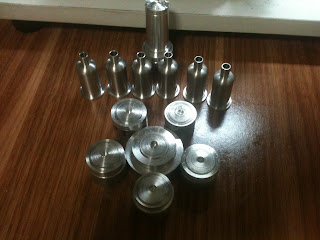As usual, pics were taken along the way. Here they are:
 |
| Started with drilling progressively bigger hole after center drilling. My boring tool needs a minimum hole size of 1/4" to start. Being Singaporean (Kia Su syndrome), I gave it a 7mm. |
 |
| Completed the "boring" operation. The marking are almost gone... This is an inexperience machinist wannabe at work. |
 |
| The back of the mount. I didn't take pics of how I managed to mill out the portion left behind. Deburring tool was used to remove the balance material. |
 |
| Good fit. I marked the 2 screw hole locations again using the digital height gauge. They're right in the middle of the 2 mounting holes on the antibacklash nut. I feel so proud of myself... |
The entire process of boring out the 23mm diameter hole started with some fear of the stock moving out of the chuck. The cut wasn't smooth at the beginning but I managed. Spindle speed was rather slow to reduce vibration as the hole is not in the middle of the rectangular block. As the length of the boring tool is less than the required depth of 25mm, I left a few mm at the back of the stock for cleaning up later. Once I get the diameter of 23mm, I adjusted the tool angle to clean up what I can of the balance. The rest was left for the deburring tool.
 |
| This is the same type of deburring tool I used for the final cleaning up. Mine has a blue and longer handle. |
I hope to complete the nut mount by the next session, if time permits. And if the A2Z horse shoe Stepper Motor Mount can be used, I'll have one less component to make to complete this mod.
When the precision leadscrew conversion is done, I'll move on to wire the spindle to the Gecko G540 VFD so that I can control the spindle rpm using gcode. Then I'll have full automation (almost) at home :-)
Almost 1am now. Better get some sleep. Some appointments lined up tomorrow.














































